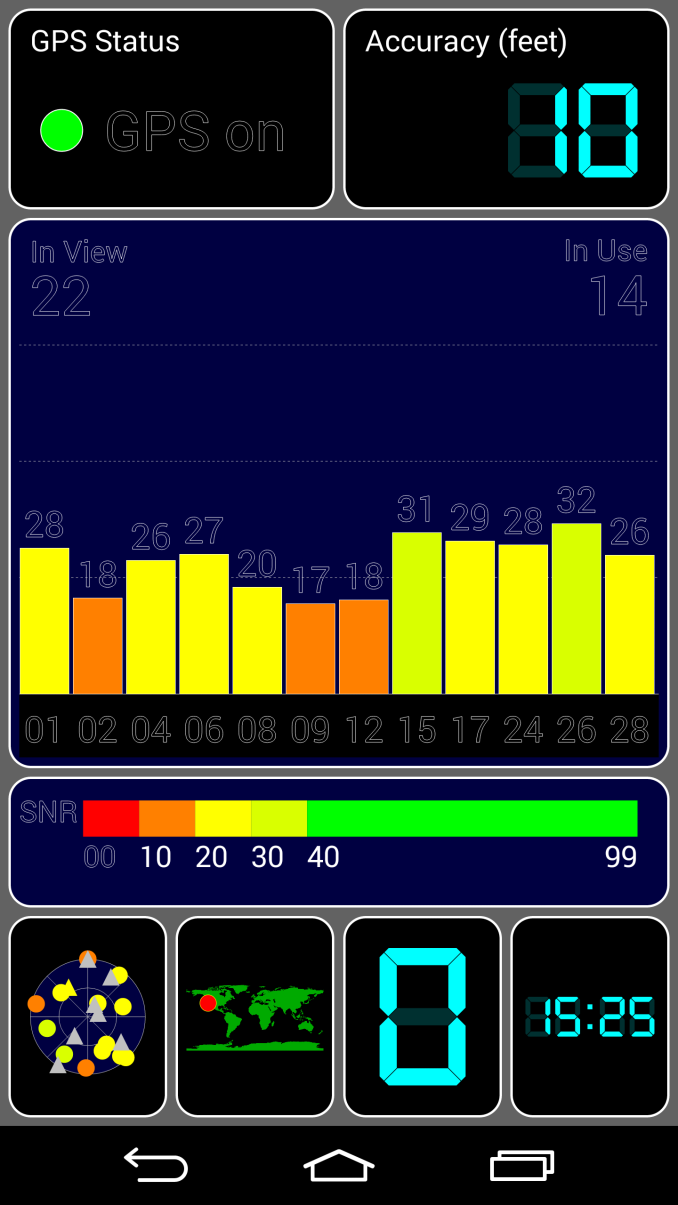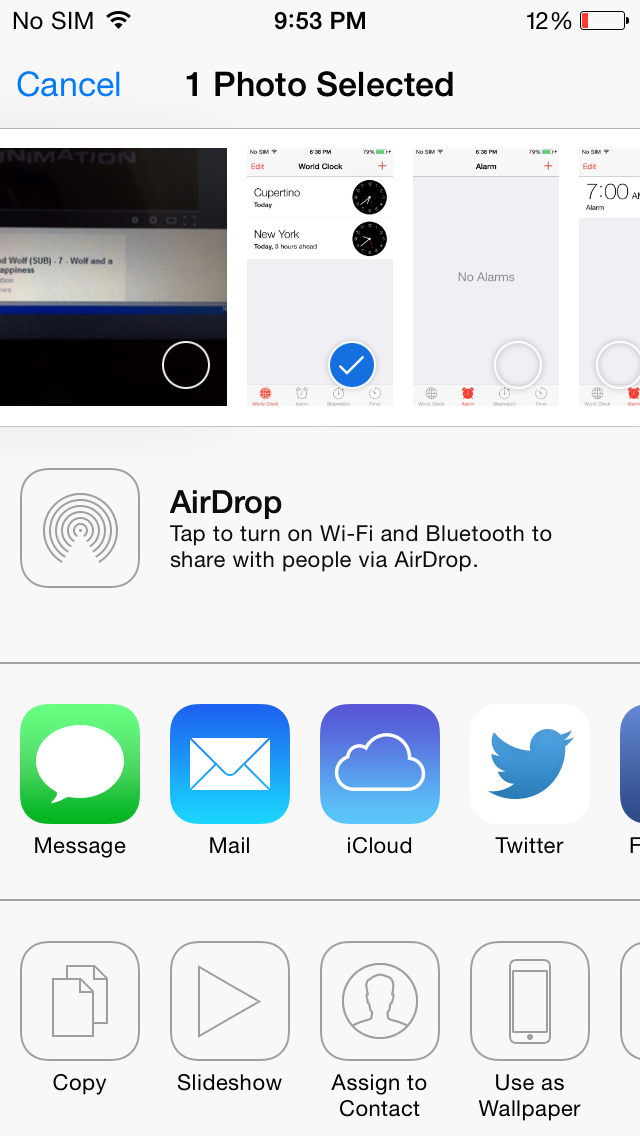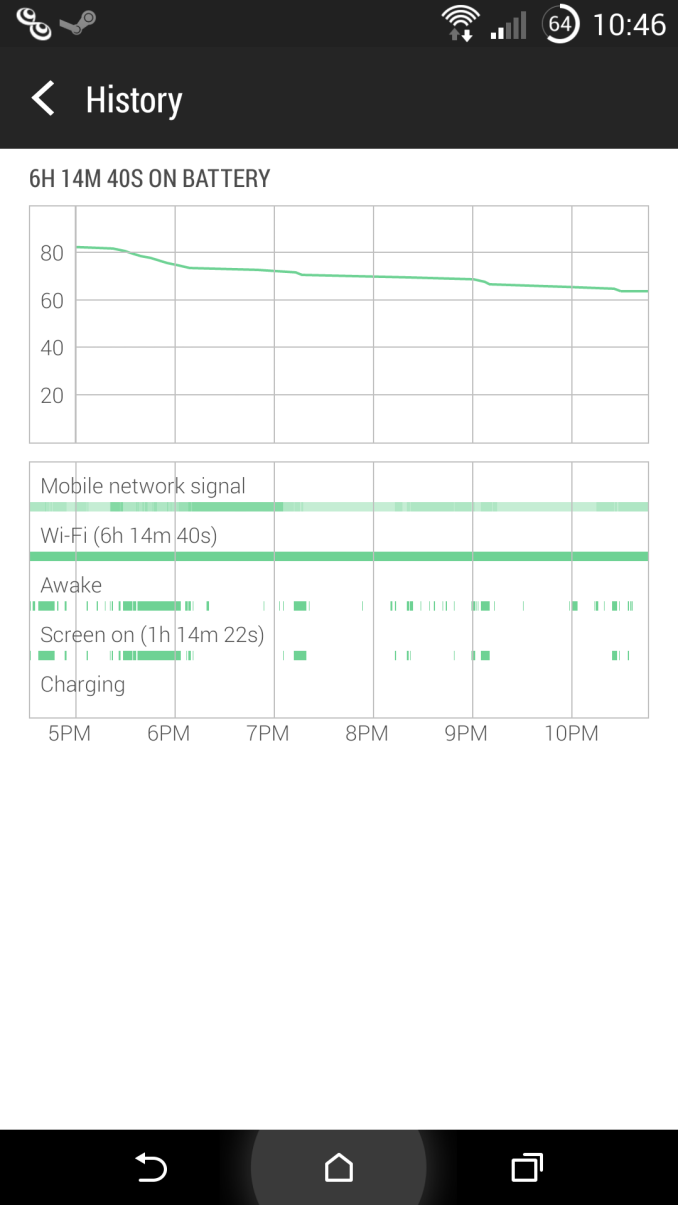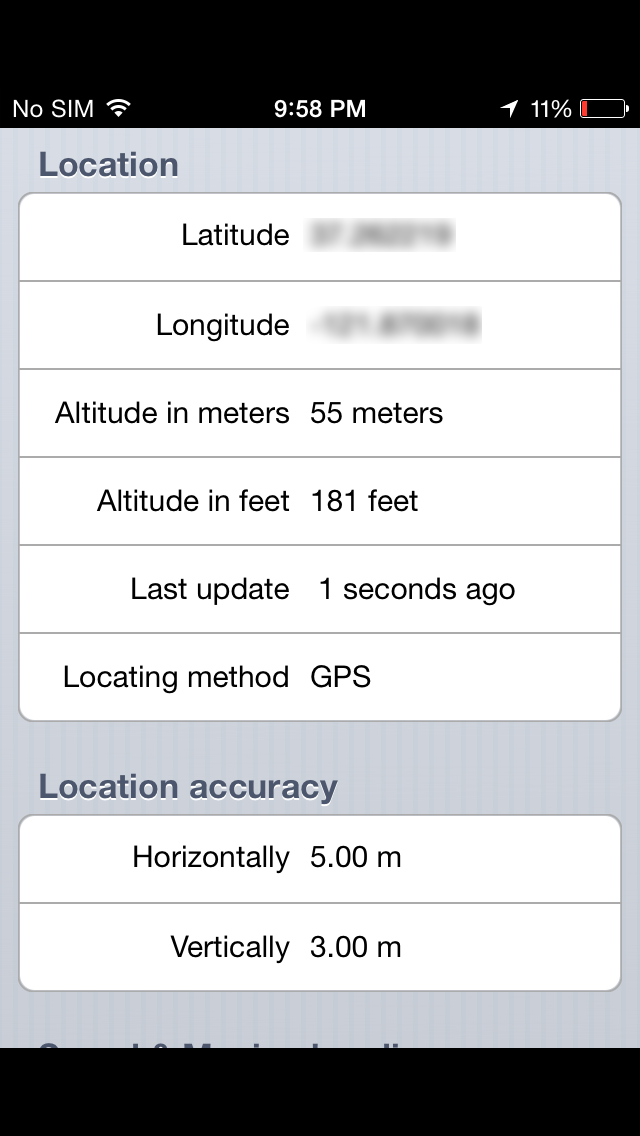A Month with the iPhone 5s: Impressions from an Android User
by Joshua Ho on August 24, 2014 7:00 AM ESTSoftware
From a purely functional perspective, there are some pain points involved in moving from Android 4.4 to iOS 7. While it’s been talked to death now, the lack of a system similar to intents on Android and the lack of customizable keyboards are definitely a bit on the frustrating side. For example, while on Android manually uploading screenshots, photos, and video to Dropbox is a relatively painless process, doing the same on iOS isn’t possible. While one of the first things I do on any Android smartphone is install SwiftKey, it’s not possible to do the same on iOS. This immediately causes my typing speed to drop, although in the case of iOS’ keyboard this is mostly due to the lack of punctuation in the letter page. However, these two immediate issues are about to be irrelevant with the release of iOS 8, so this is more of a temporary issue than a permanent one.
Although also temporary, for those that have become accustomed to the significant amount of custom control provided by camera apps from HTC and Samsung, the iOS camera application is comparatively barren. There's the ability to toggle HDR, flash, tap to focus/expose and lock focus/exposure. In effect, there's no real way to set manual controls. While the auto mode is pretty much as good as it gets, I find myself missing manual controls when it comes to taking macro photos and in other similarly extreme conditions.
There are a few other issues though. To someone that has almost solely used Android smartphones, the notification drawer has some odd behavior. It’s never really made sense to me why notifications can only be cleared by application. I definitely think a clear all notifications button would be a good addition for the future, but this is only a significant problem if a large number of notifications build up without getting cleared away. I'm also not sure what the value is to segregating "all" and "missed" notifications. Android definitely handles this better, although it probably makes more sense to those that have used iOS' notification system from the start.
Outside of these issues, there’s quite a lot to like. The vast majority of applications that I used had a consistent style that fit with iOS 7, with no strange scaling issues or unexpected behavior. This still tends to be a problem in Android, so it’s refreshing to have an app ecosystem that tends to keep up with the design guidelines set with each new iOS release. There’s also just about no stuttering or pausing in the experience. While Android L and ART should bring much better performance to Android smartphones, in iOS it seems that such performance issues haven’t really existed in the first place.
iOS and Android/Sense 6 battery stats
Of course, while there are some issues that could be fixed, there are others that are much more fundamental. One of these is direct access to the file system. While it’s quite convenient in Android to trawl through system files to learn about the underlying hardware and move around data using a file explorer, it makes sense to completely sandbox applications from each other to improve security. Another advantage of sandboxing applications is that orphan files are nonexistent, which is an issue on Android devices.
In addition to file system differences, it’s a bit frustrating to not have detailed battery life statistics when it comes to how much CPU time each application consumes, how long application wakes up the system while the screen is off, and similar details. However, it once again makes sense for Apple to do this. After all, iOS battery management is already quite stringent. In general, applications are strictly regulated and most cannot run in the background for any significant amount of time. On Android, it's possible for a single rogue application to ruin battery life, but this same system means that multitasking tends to be much faster and smoother.
If anything, this may be the real difference that matters when comparing iOS and Android. While Android and iOS are largely similar in features, there is a fundamental divide in the way the two OSes are designed. At its core, iOS is designed with average users in mind. As a result, there’s a strong emphasis on making things “just work” and hiding information that would simply confuse and frustrate people that don’t care about the underlying hardware and software. Android at its core is targeted at those that want to have the full PC experience on their phone, and as a result there’s much more information and low level functionality for those that want it. However, this can easily be frustrating and confusing for the end user. Of course, it’s fully possible for iOS to adopt features that would be targeted at advanced users, and Android can be changed to be more user friendly. If anything, this hypothetical has been the case for the past few years. Over time, Android has become a more friendly OS with the removal of the search and menu keys, going from the dark themes of 2.3 and 3.0 to the brighter, cleaner designs of today. Things like Google Maps have become considerably more simplistic, and even microSD slots had significant restrictions added to them in an attempt to simplify the user experience. Similarly, the fact that manual camera controls are even possible speaks to how Apple is adding more niche features.

GPS Info! on iOS and GPS Test on Android
However, the differences remain, and understanding this is as simple as looking at how equivalent features are implemented. For example, location services in iOS are binary in nature, and can only be turned on and off globally or for each application. In Android there’s noticeably more nuance. Location can be done only by on-device GPS, or by using WiFi/cell tower location, or by using both. In addition, it’s possible to view GPS data such as per-satellite SNR and number of satellites used and in view.
Final Words
At the end of the day, the iPhone 5s has aged quite well. While the hardware quality is a cut above, it’s more than just a matter of pure hardware. It’s clear to me that the user experience wouldn’t be nearly as good without Apple’s strong control over software. TouchID is quite possibly the best example of this, as there’s no need to wait for an official API to support fingerprint authentication for App Store purchases or other similar situations. While I felt a bit constrained by the limits in the operating system, the integration and overall quality of the experience outweighed these disadvantages. I’m not quite sure if either is better at this point, as while I definitely enjoy the amount of low-level information and customization available on Android, iOS has a much more polished and highly integrated experience.
However, in the long run it seems likely that they will converge towards largely similar feature sets. This doesn't mean that they'll be identical, as there's a distinct parallel in the Mac vs Windows debate. In Windows, adoption of new hardware features into the OS tended to be slower and not as well integrated as the OS vendor and multiple OEMs had to try and coordinate such a task. However, a major advantage of such a system was that backwards compatibity and flexibility was greater, even if it was more complicated for the end user. Similarly, Mac has tended to have new features at a faster pace and with better integration, such as high DPI displays. However, the result tends towards less control over low-level settings and less visibility into low-level information. The tight integration between hardware and software also means that it's harder to provide extensive backwards compatibility.
Of course, these are mostly broad strokes. It's not really possible to predict what the future holds, but even now we can see major differences. Google has allowed for custom OEM UIs on top of Android, and doesn't profit directly from the sale of Android OS. Similarly, the nature of smartphones dictates tight integration, so it's not really possible to upgrade the OS without a new BSP and major work on the part of the OEM to push an OTA. Apple has also managed to ensure that the app ecosystem of iOS is equal to or greater than any other mobile OS, something that was a major stumbling block with Mac OS in the early days of personal computing. While a great deal of maturation has occured in the smartphone market, there is still a long road ahead before the story can end.



_575px.PNG)
_575px.PNG)
_575px.PNG)










197 Comments
View All Comments
OldTechLover - Sunday, August 24, 2014 - link
Androids may be micro-managed, but not for the reasons you say. They are micro-managed because they CAN BE, not because they need to be. Work gave me an apple phone after Blackberry started declining (Verizon salespeople are fabulous for this!). I was given an Iphone 4, it was NOWHERE near as capable for email as my blackberry was. Now, if I could have micro-managed it and put a different email client on the device, maybe that would be different. The experience was horrible. I was being forced to use the email client. What a joke. Getting on average of 700 emails a day, and getting to delete 5 at a time was a joke. Also, looking at the log files of the iphone showed the thing crashed several times a day. I admit it recovered nicely from the crashes.After complaining about this phone to my company (this took months, though I wasn't alone in complaining), I got a Galaxy Note II. I 'micro-managed' the crap out of it. Don't like the stock email? No worries, just download a different one (there are AT LEAST 2 dozen other clients out there). I currently use K-@ mail. Its simply wonderful!
Don't like the stock browser? No worries, just download another (and its not just an overlay to the stock browser either). I'm using Next browser. Its no frills and fast.
Don't like the icons or the launcher? No worries, just change it!
Best yet, click on a sound file from file manager (oh thats right, file manager, yet another micro-managed thing) and click 'set as ringtone'. Try that elsewhere.
As it is now, I ftp flac and mp3 files from my home network to my note and can play them in the music player of choice. I am using Media Monkey, and it also controls Media Monkey on my home system.
Micro-managed my ass. Its called customization.
bernstein - Sunday, August 24, 2014 - link
yada yada yada... got a galaxy note 3 because i thought getting a new iphone too expensive & too small... guess what, after trying a dozen (imho crappy) launchers, roms, hundreds of apps (caldendars, dialers, mail, ...) i gave in and bought an iphone5s... despite hating apple. *customize my ass*just one thing: even right out of the box the note 3 has worse battery life than the iphone4s. it gets mesurably better when you toggle bt/wlan/gps/... manually off. but not much.
cupholder - Sunday, August 24, 2014 - link
You're a liar. The end. My Galaxy Note 3 gets ~36 hours of battery typically if I don't screw with it, and that translates to about 8-9 hours of screen on time. This is with BT on(yay Ford car), Wifi on, LTE on. The iPhone 4 I had previously would make it through a day, usually. More than that? No. The 5s I had briefly before returning it and getting the Note 3 didn't really make it through the day at all.ESC2000 - Tuesday, August 26, 2014 - link
Yeah at least the trolls could pick android phones for which lame battery life is a possibility instead of picking the notes which have awesome battery life (easily more than a day) while the beloved iPhone can't make it 24+ hours without a charge *rolls eyes*JRX16 - Saturday, August 30, 2014 - link
That's amazing because I regularly get two full days with everything on out of my iPhone 5s. I admit that's my average light usage, but even on heavy use days I've never been able to kill the phone before 10pm. There are bad batteries in faulty iPhones, and those cases are the ones you hear about (people who don't have problems usually are never heard from). Also, background app refresh causes more battery drain, something which is also micromanaged by most people by app on Android (I've owned a few and don't want weather updating every 15 minutes of course).Bownce - Tuesday, September 16, 2014 - link
With a 'day 1" iPhone 5 (not an S), I was recently seeing shorter durations between charges. A 2 year phone? Surprise? NAY NAY! Free battery swap via Apple. I thought it was doing fine before but now it's 2+ days between charges.RoninX - Monday, August 25, 2014 - link
Oh, nonsense. I have a Galaxy Note 3, and I leave everything on, and never have any trouble getting through a full day, including 8+ hours of listening to music, push email for both Gmail and Exchange, web surfing on WiFi and 4G, GPS navigation, etc.vFunct - Sunday, August 24, 2014 - link
You know what's better than customization?NOT customization.
There is absolutely no compelling reason one needs to customize a smartphone. They were all designed to work as-is. You don't need to add anything else to make the experience better. You just need to "hold it right".
If you have to customize your phone, that means you're using it wrong.
Use it the way the manufacturer intended for it to be used, and you'll be happy.
Customizing a phone is the equivalent to customizing a refrigerator. Just don't do it. Be happy with it as is.
Don't do stupid things like listen to FLAC files (seriously? people care about lossless? Are you a bat?) Don't do stupid things like FTP or change icons, or any of the other pointless things people do with their phones. Don't have 700 emails a day. Unsubscribe from all your email lists. Have your email server set up filters.
Do things like go to a bar and have drinks, or play sports, or go outside.
Don't do things like browse files on your smartphone.
No one ever needs to customize their phone.
Ever.
MobiusOne - Sunday, August 24, 2014 - link
Maybe I don't want every single useless, permanently installed app on my homescreen? You're delusional if you think no one wants their smartphone to be more efficient.People have needs beyond angry birds and Facebook, and putting tinkerers down is just retarded. Your phone is your multitool, and if you don't want it to be as efficient as possible you're frankly a bit dull.
.FLAC is for audiophiles, people that own -not shitty- audio equipment. Real headphones instead of that fruity beats shit.
I don't want useless OEM shit clogging up my home screens and I definitely don't want ugly looking folders everywhere.
You can't change your main browser, you can't use gmail by default, you can't use a different gallery by default. You can't transfer MP3's without iTunes watching over you, you can't auto-backup photos, you can't type the way you want, and you can't even have a notepad on your home screen.
Don't change anything, don't personalize, don't change shit that you don't like. Don't make things the way you want them to be, Tim Cook knows best.
So much for Apple being for 'Creative' types.
vFunct - Sunday, August 24, 2014 - link
There is no such thing as an audiophile. That is just a misnomer for people with manic OCD.Nobody has actually ever enjoyed FLAC over 256kb MP3. You don't even notice it. That's why you don't need an FLAC player, which is why you don't need to customize your device because you don't need a FLAC player.
FLAC is basically for people with psychological defects.
And i'm talking as a guy with 20/5 hearing with a full SACD sound system in a custom acoustically engineered recording studio, as expensive as it gets.
I don't consider myself an audiophile either, because I'm self-aware enough to know that I can enjoy music on crappy headphones in the subway just as well as in my studio.
Again, there is absolutely no need to personalize or customize a smartphone. It is better to fix your own psychological problems first before you waste time on your phone.
Admitting you use FLAC is like admitting your psychological problems publicly.